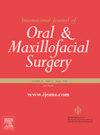Nomogram for predicting postoperative temporomandibular joint degeneration after mandibulectomy for oral cavity cancer: a study on patients using CT and MRI data
IF 2.2
3区 医学
Q2 DENTISTRY, ORAL SURGERY & MEDICINE
International journal of oral and maxillofacial surgery
Pub Date : 2024-11-01
DOI:10.1016/j.ijom.2024.10.010
引用次数: 0
Abstract
The aim of this study was to develop a model for predicting the risk of postoperative temporomandibular joint osteoarthritis (TMJOA) in patients receiving a segmental or marginal mandibulectomy for oral cavity cancer . A total of 371 patients with buccal or gingival cancer who underwent mandibulectomy were included in this retrospective cohort study. Demographic data, computed tomography, and magnetic resonance images were reviewed. Univariate and multivariate Cox regression analyses were performed to develop a nomogram to predict post-mandibulectomy TMJOA. TMJOA was identified in 81 of the 371 patients at 2 years and 107 at 4 years. The predictors of post-mandibulectomy TMJOA were segmental mandibulectomy (hazard ratio (HR) 2.51, 95% confidence interval (CI) 1.64–3.83, P < 0.001), age ≥ 62.5 years (HR 2.28, 95% CI 1.53–3.40, P < 0.001), BMI < 24.1 kg/m2 (HR 2.13, 95% CI 1.45–3.13, P < 0.001), and American Joint Committee on Cancer stage IVa/IVb (HR 2.21, 95% CI 1.38–3.56, P = 0.001). The nomogram developed in this study exhibited good predictive capacity (area under the curve 0.742, 95% CI 0.679–0.804). The proposed model for predicting post-mandibulectomy TMJOA in patients with buccal or gingival cancer can identify high-risk individuals for early preventive oral rehabilitation.
预测口腔癌下颌骨切除术后颞下颌关节退化的提名图:利用 CT 和 MRI 数据对患者进行的研究。
本研究的目的是建立一个模型,用于预测因口腔癌接受下颌骨节段或边缘切除术的患者术后颞下颌关节骨关节炎(TMJOA)的风险。这项回顾性队列研究共纳入了 371 名接受下颌骨切除术的颊癌或牙龈癌患者。研究人员审查了人口统计学数据、计算机断层扫描和磁共振图像。通过单变量和多变量 Cox 回归分析,得出了预测下颌骨切除术后 TMJOA 的提名图。在 371 名患者中,有 81 人在 2 年时、107 人在 4 年时发现 TMJOA。下颌骨切除术后 TMJOA 的预测因素是节段性下颌骨切除术(危险比 (HR) 2.51,95% 置信区间 (CI) 1.64-3.83,P 2)(HR 2.13,95% CI 1.45-3.13,P 3)。
本文章由计算机程序翻译,如有差异,请以英文原文为准。
求助全文
约1分钟内获得全文
求助全文
来源期刊
CiteScore
5.10
自引率
4.20%
发文量
318
审稿时长
78 days
期刊介绍:
The International Journal of Oral & Maxillofacial Surgery is one of the leading journals in oral and maxillofacial surgery in the world. The Journal publishes papers of the highest scientific merit and widest possible scope on work in oral and maxillofacial surgery and supporting specialties.
The Journal is divided into sections, ensuring every aspect of oral and maxillofacial surgery is covered fully through a range of invited review articles, leading clinical and research articles, technical notes, abstracts, case reports and others. The sections include:
• Congenital and craniofacial deformities
• Orthognathic Surgery/Aesthetic facial surgery
• Trauma
• TMJ disorders
• Head and neck oncology
• Reconstructive surgery
• Implantology/Dentoalveolar surgery
• Clinical Pathology
• Oral Medicine
• Research and emerging technologies.

 求助内容:
求助内容: 应助结果提醒方式:
应助结果提醒方式:


